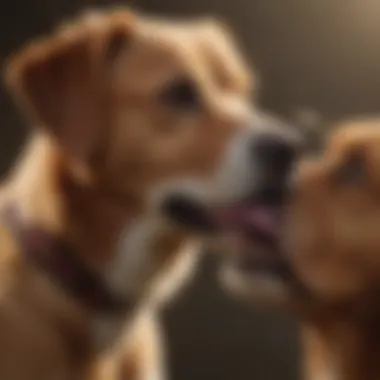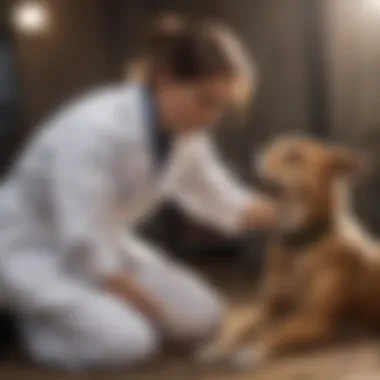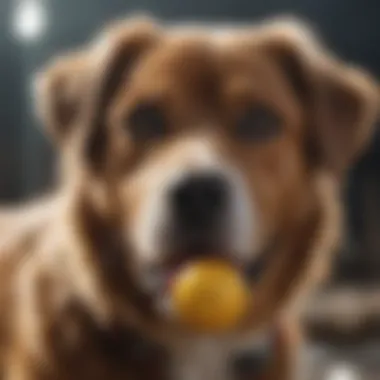Essential Steps to Help a Choking Dog in Emergencies


Intro
A choking dog can be a frantic and distressing situation for any pet owner. Being prepared to handle such emergencies can be the difference between life and death for your canine companion. Understanding how to react and what steps to take in these moments is essential. This guide aims to arm you with vital information about choking in dogs, the methods to assist them, and when to seek further help from veterinary professionals.
Understanding Your Pet
Understanding your pet’s behavior, breed traits, and temperament can play a significant role in preventing choking incidents. Certain dog breeds have unique feeding habits, and some may be more prone to choking due to their physical characteristics.
Breed Traits
Each breed has its own set of traits. For instance, dogs with short snouts, such as bulldogs and pugs, can be more susceptible to respiratory issues. Others, like retrievers, tend to be enthusiastic eaters, which may increase the risk of them choking on food or toys.
Common Temperaments
The temperament of your dog influences its behavior during feeding and playtimes. A nervous dog might gulp food quickly, while a more relaxed one may take its time. Recognizing these patterns can help you manage feeding and reduce the risk of choking.
Special Needs
Some dogs may have special dietary needs or health issues, making it crucial to serve them food that doesn’t pose a risk of swallowing hazards. If your dog has a history of choking or similar problems, consult your vet for tailored advice.
Pet Care Essentials
Maintaining your dog’s overall health is vital in minimizing emergencies, including choking incidents. A well-rounded approach to pet care involves attention to nutrition, grooming, and healthcare.
Nutrition and Feeding Guidelines
Choose high-quality dog food appropriate for your pet’s age and size. Feeding smaller, frequent meals can prevent gulping. Avoid giving your dog bones or other items that can splinter.
Grooming Tips and Techniques
Regular grooming is essential for your pet’s hygiene and comfort. Pay attention to teeth cleaning. Plaque buildup can lead to behavioral issues during feeding time.
Health and Wellness
A veterinary check-up is essential. Regular vet visits can ensure that any underlying health issues are addressed. Discuss your pet’s diet and activities to ensure they are well-balanced.
Training and Behavior
Training is fundamental in shaping your dog’s behavior. Teaching basic commands can help in emergencies, including when your dog is choking.
Basic Training Techniques
Start with commands like “drop it” or “leave it.” These simple phrases can prove very useful in a choking incident, as they prompt your dog to let go of hazardous objects.
Behavioral Problems and Solutions
Locating the source of your dog’s anxiety or destructive behavior is important. By addressing these issues, you can reduce incidents that may lead to choking.
Mental Stimulation Activities
Engage your dog with mental stimulation activities. Toys that promote problem-solving skills can keep them occupied, thereby reducing the likelihood of them swallowing inappropriate items.
Engaging with Your Pet
Bonding with your pet through interactive activities can improve their behavior and well-being.
Interactive Games and Toys
Use toys designed for durability. Avoid small toys that can easily be swallowed or broken into smaller, choke-able parts.
Safe Outdoor Activities
Supervised outdoor playtimes can help keep your pet active and mentally stimulated. Always monitor them closely to prevent incidents.
Family-Friendly Pet Interactions
Teach your children how to interact safely with pets. Explain the importance of not pulling on dog’s ears or tails, which can lead to unexpected reactions or behavior that increases choking risks.


Pet Adoption and Integration
Adopting a pet is a significant commitment. Understanding the responsibilities involved can prevent future emergencies related to choking.
Choosing the Right Pet for Your Lifestyle
Research breeds and their specific needs. Understand how your lifestyle aligns with the characteristics of different dogs before bringing one home.
Preparing Your Home for a New Pet
Ensure that choking hazards are eliminated from your home. Remove small objects, electronics cords, and keep food out of your pet’s reach.
Tips for Smooth Prolusion
When introducing a new pet, allow gradual interactions with family members. Keep an eye on how they behave around small toys or items that could be potential hazards.
Remember, your vigilance is your pet’s best defense. Regular training, adequate nutrition, and emergency preparedness will greatly enhance your ability to handle choking situations effectively.
Understanding Choking in Dogs
Choking in dogs is a critical issue that can pose serious risks to their health and wellbeing. Recognizing the signs and causes of choking can equip pet owners with the necessary knowledge to act swiftly in an emergency. Understanding the dynamics of choking helps in preparing for potential incidents, reducing fright, and hindering further injury. By educating dog owners about this serious condition, we can foster better relationships between pet and owner and promote safe environments for dogs.
Definition of Choking
Choking occurs when an object obstructs the airway, preventing normal airflow to the lungs. This can lead to panic in a dog, resulting in potential suffocation. Choking can happen in moments and requires prompt recognition and action to mitigate risks. It can occur silently at first, making awareness vital. Understanding how the airway functions in dogs can assist in better comprehension of this condition.
Common Causes of Choking
Understanding the causes of choking helps in creating preventive measures to keep dogs safe.
Foreign Objects
Foreign objects are among the most frequent culprits causing choking incidents in dogs. Dogs are naturally curious and often explore their environment by chewing or swallowing items that can be hazardous. Items like small toys, sticks, or even clothing can easily become lodged in their throats. The variability in size and shape of these objects means that any household item could pose a risk.
Food-Related Incidents
Food-related choking typically arises from improperly managed feeding practices. Dogs that eat too quickly, or those that consume large pieces of food, are at increased risk. Some foods can pose greater hazards, such as bones or large chunks of raw meat. Understanding food-related risks can guide owners toward better feeding routines, minimizing choking incidents during mealtime.
Anatomical Factors
Certain anatomical features can predispose specific breeds of dogs to choking. Breeds like Bulldogs or Pugs have shorter snouts, making it more difficult for them to manage large pieces of food or objects. Recognizing these factors is crucial in understanding that not all dogs face the same level of risk. Owners must be aware of their dog's physical characteristics and how these may influence choking susceptibility.
Signs That a Dog is Choking
Recognizing the signs of choking is paramount for timely intervention.
Gagging or Coughing
Gagging or coughing can indicate that a dog is trying to expel a lodged object. These symptoms may present themselves occasionally, leading to false reassurance. However, persistent gagging signifies a more urgent situation. Noticing these signs early is crucial for prompt action and assistance, ensuring the dog’s safety.
Difficulty Breathing
Difficulty breathing is a telltale sign that should not be overlooked. This may manifest as labored breaths, whimpering, or unusual postures as the dog struggles for air. Observing changes in how a dog breathes can help detect choking sooner. Owners should remain vigilant if they see their dog exhibiting distress during normal activities.
Excessive Drooling
Excessive drooling may accompany other signs of choking. It may indicate that a dog is in distress or struggling to breathe properly. Monitoring drooling in conjunction with other symptoms can aid in differentiating choking from other health issues, prompting immediate responses. Excessive drooling often suggests that the dog is unable to swallow appropriately, raising concerns about possible choking.
Understanding these signs not only prepares owners for emergencies but also builds awareness of a dog’s general health.
Immediate Actions to Take
In the face of a choking dog, immediate actions can be the difference between life and death. Prompt response is crucial, as every second counts when a dog is struggling for air. Whether you are a pet owner or someone who finds themselves in this challenging situation, knowing how to act swiftly can reduce panic and effectively manage the emergency. This section outlines core actions that should be taken to ensure the safety and well-being of your dog.
Assessing the Situation
Before delving into specific actions, it is important to assess the situation. Observe the dog's condition carefully. Is it really choking, or is it simply coughing? Look for signs such as gagging, labored breathing, or distress. If the dog is still able to cough or breathe intermittently, it may be best to let it continue. In many cases, a dog's reflex to cough can help dislodge the foreign object. Evaluating the severity will help you decide the most appropriate course of action.


The Heimlich Maneuver for Dogs
The Heimlich Maneuver can be a life-saving technique. It is essential, but the method varies according to the dog's size.
Small Dogs
For small dogs, the technique requires some adjustments. Hold the dog with one arm around its abdomen. With your other hand, make a fist and place it just below the rib cage. Give a quick, upward thrust. This can help create enough pressure to expel the object. Small dogs are more delicate, so ensure that you do not apply excessive force. Keep a close eye on their respiratory pattern, as it will guide your actions and ensure safety during the process.
Medium to Large Dogs
The approach for medium to large dogs differs slightly. Stand behind the dog and reach your arms around their waist. With a clenched fist, apply pressure underneath the rib cage with below the diaphragm. An upward thrust is necessary to help push out the object. Given their larger size, more force might be required, but this should still be done with care. Knowing that larger dogs can sometimes be more volatile during distress, it is advisable to remain calm and methodical.
Using Back Blows
If the Heimlich maneuver does not yield results, back blows can be effective. Position yourself behind the dog, ensuring you maintain control. Use the heel of your hand to deliver firm blows between the shoulder blades. This technique creates a sudden force that may dislodge the obstruction. Again, focus on maintaining your composure; your calmness will reflect on the dog, which could help reduce their panic.
Checking the Mouth
After attempting these techniques, it is vital to check the dog's mouth for any visible objects. If safe to do so, gently open their mouth and look for the obstruction. Do not put your fingers blindly in the mouth, as this may lead to further complications or injury. If visible, try to grasp it with your fingers or tweezers, taking great care not to push it further down. If you cannot easily remove the object, it may be time to seek veterinary assistance.
Ensure to remain composed throughout the process. Panic can impede your ability to effectively help your dog.
Navigating an emergency involving a choking dog is undeniably stressful. However, knowing the immediate actions to take can greatly improve the chances of a positive outcome. Mastering these skills can equip dog owners with the confidence needed to manage this crisis effectively.
Veterinary Assistance
Veterinary assistance plays a crucial role in ensuring the health and safety of a dog that may be choking. While immediate actions taken by a pet owner can sometimes resolve the issue, professional veterinary care is essential for thorough evaluation and treatment. Even if a dog seems to recover from choking, underlying injuries or complications may not be immediately apparent. Thus, understanding when and why to seek veterinary care is paramount for any dog owner.
When to Contact a Veterinarian
It is vital to know the right moment to contact a veterinarian during a choking incident. Here are some indicators:
- Persistent Symptoms: If the dog continues to show signs of distress, such as gagging, coughing, or trying to vomit after initial intervention, veterinary help should be sought.
- Loss of Consciousness: A dog that has collapsed or is unresponsive requires immediate veterinary attention. This signifies a more severe choking incident or other serious health issues.
- Breathlessness: Difficulty breathing that lasts longer than a few minutes indicates that the situation may not resolve without external help.
- Visible Obstruction: If a foreign object can be seen in the dog’s throat and cannot be safely removed, a vet will have the proper tools and expertise to handle the issue.
Contacting a veterinarian promptly can make a significant difference in outcomes. In emergency situations, every moment counts.
What to Expect at the Vet's Office
When a dog arrives at the veterinary office after a choking incident, the staff typically follows a systematic approach to ensure effective treatment:
- Initial Assessment: The veterinarian will quickly assess the dog's condition, checking for vital signs and the level of consciousness.
- Diagnostic Procedures: Depending on the situation, the vet may conduct X-rays or endoscopy to locate any obstructions or assess for internal injuries.
- Treatment Options: Based on findings, treatment can vary:
- Post-Treatment Instructions: After the immediate crises addressed, the vet will provide details on post-care, which may include dietary changes or behavior adjustments to prevent future incidents.
- Removal of Objects: If an object is lodged in the throat, the veterinarian may use specialized instruments to extract it.
- Medication: In some cases, medication may be necessary to reduce inflammation or treat post-choking complications.
- Observation: The dog may need to be monitored for a period to ensure recovery and observe for any further complications arising from the choking incident.
Remember, seeking veterinary assistance not only ensures the immediate safety of your pet but also aids in their long-term health.
Preventive Measures
Preventive measures are crucial in reducing the risk of choking in dogs. By understanding how certain choices can impact your dog’s safety, owners can create a secure environment that minimizes hazards. This section will explore specific elements such as toy selection, mealtime management, and training that contribute to a safer atmosphere for your pet.
Choosing the Right Toys
Selecting toys that are safe for your dog is vital in preventing choking incidents. Not all toys are designed with safety in mind. Rubber toys, for example, are a better choice than toys made of materials that can easily splinter, such as soft plastic. Look for toys that are appropriate for your dog’s size and chewing strength.
A well-chosen toy not only entertains but also can prevent dangerous accidents.
Some toys come with labels indicating their safety for specific breeds and sizes. This is an important characteristic to consider. Durable toys tend to possess a unique feature that helps resist tearing and destruction during play. However, it is essential to regularly inspect the toys for wear. If a toy becomes damaged, it might pose a choking hazard, which brings its usability into question. Maintaining a rotation of toys can also keep your dog engaged without overwhelming them with too many choices.
Managing Mealtime
How you manage your dog’s mealtime can significantly impact the risk of choking. Two main aspects to focus on are feeding practices and the supervision during meals.
Feeding Practices
Feeding practices play a crucial role in preventing choking. One recommended method is using a puzzle feeder. This device slows down the eating process, ensuring dogs chew their food thoroughly. Slowed eating is a key characteristic that minimizes the chance of choking. Dogs tend to rush through meals, particularly when they are hungry.
Introducing a slow feeder can provide a clear advantage in this regard. The unique feature of this feeding practice is that it transforms mealtime into a challenge and encourages mental stimulation while eating. However, some dogs may initially take longer to adjust. Patience may be needed, but the benefits outweigh the disadvantages.


Supervision During Meals
Supervision during meals is another vital aspect to consider. Closely monitoring your dog while it eats can allow for immediate intervention should any issues arise. This practice can quickly become habitual among pet owners and is a beneficial choice for any household.
The unique feature of this supervision is that you can ensure your dog eats at a manageable pace, allowing you to observe and prevent any potential choking incidents. While it may not always be possible to supervise every meal, making an effort during high-risk eating times is critical. This vigilance can help create a safer feeding environment for your furry friend.
Training and Behavior Management
Training plays an important role in behavior management and can also reduce choke risks. Teaching your dog basic commands such as “leave it” can help them avoid swallowing inappropriate items. It encourages the development of an understanding to stop or retrieve objects that may become dangerous. Therefore, investing time in behavior training is not only beneficial but essential for any responsible pet owner.
Recognizing Potential Risks
Understanding the risks associated with choking in dogs is vital for every pet owner. Certain breeds are more prone to choking due to their physical traits. Additionally, the environment in which a dog lives can introduce various hazards that may lead to choking incidents. Recognizing these risks allows pet owners to take proactive measures, ultimately improving the safety of their dogs and reducing emergencies related to choking.
High-Risk Breeds
Certain dog breeds have anatomical features that make them more susceptible to choking. Breeds such as Pugs, Bulldogs, and Dachshunds often have short faces or elongated necks, which can complicate their breathing and swallowing. These breeds may struggle with larger chunks of food or objects that can easily get lodged in their throats. Awareness of these characteristics can empower owners to adjust feeding practices and toy selections, tailoring their approach to meet the needs of these animals.
Environmental Factors
Outdoor Hazards
Outdoor environments present unique challenges that may contribute to choking. When dogs are outside, they often encounter various items, such as sticks, stones, or even pieces of trash, that can easily be ingested. The key characteristic of outdoor hazards is their unpredictability. Unlike controlled indoor spaces, outdoor areas may contain foreign objects that a dog might find alluring.
One significant advantage of recognizing these outdoor hazards is that it encourages pet owners to supervise their dogs closely while playing in the yard or at parks. Using leashes and providing designated play areas can mitigate risks. Additionally, understanding outdoor hazards helps owners create safe experiences while allowing dogs to enjoy their time outdoors.
Household Items
Household items can also pose a risk of choking to dogs. Common objects such as rubber bands, small toys, or even food packaging can end up being lifesaving dangers. The essential feature of household items is their accessibility; dogs are often curious and might explore these items, leading to potential choking incidents.
Keeping potentially harmful items out of reach can significantly reduce choking risks. For instance, utilizing storage bins and safety locks on cabinets ensures that dogs do not have access to harmful objects. This preventative approach can help create a safer living environment for dogs, giving owners peace of mind.
Post-Incident Care
After a choking incident, the immediate concern does not end when the airway is clear. The care following the removal of the obstruction is critical for ensuring the dog's overall recovery and health. This phase of care encompasses monitoring the recovery process and being vigilant for any signs of complications that may arise.
Monitoring Recovery
Monitoring your dog after a choking experience is important for several reasons. First, even if your pet seems to have returned to normal, they may still be experiencing internal issues. Dogs can suffer from inflammation or irritation in their throat that isn't immediately visible. Therefore, staying alert for subtle changes in their behavior or health is essential.
It is advisable to observe the following:
- Breathing Patterns: Check for labored breathing or coughing. If these symptoms persist, seek veterinary help.
- Appetite Changes: Monitor your dog's willingness to eat. A sudden loss of appetite can indicate throat discomfort.
- Behavioral Changes: Watch for signs of anxiety or lethargy. If your dog is unusually still or seems distressed, consult a veterinarian.
Emphasizing a calm environment during this period aids in recovery. Allow your dog a quiet space to rest, as stress can negatively impact their healing.
Signs of Complications
Even after a choking incident, complications can emerge that require immediate attention. Certain signs may indicate that your dog needs veterinary care:
- Persistent Coughing: If your dog continues to cough or gag after the incident, it could suggest a remaining irritant in the airway.
- Expelling Foamy or Bloody Mucus: This can signal serious trauma or infection.
- Difficulty Swallowing: If your dog exhibits signs of pain when trying to eat or drink, it may indicate that the throat has been injured.
- Changes in Energy Levels: Unusual lethargy or signs of distress can highlight underlying medical issues.
Always err on the side of caution. If any concerning symptoms arise, getting professional help is better to avoid further complications.
In summary, post-incident care requires careful observation and proactive measures. It can significantly improve your dog's chances for a swift recovery and the restoration of their overall health.
Finale
In this article, we have explored the essential components of assisting a choking dog. Understanding the signs of choking and knowing how to respond can make the difference between life and death for your pet. This knowledge is crucial not only for the immediate response but also for overall pet care.
Summary of Key Points
To summarize, the main points discussed include:
- Recognizing choking signs such as gagging, difficulty breathing, and excessive drooling.
- Immediate actions like assessing the situation and performing the Heimlich maneuver or using back blows.
- The importance of contacting a veterinarian when needed.
- Preventive measures to avoid choking incidents in the first place, including managing mealtime and selecting appropriate toys.
By understanding these aspects, pet owners can act promptly and effectively in emergencies.
Final Thoughts on Choking Prevention
Preventing choking is as essential as knowing how to react in an emergency. Regularly evaluating and modifying your dog's environment is key to minimizing risks. For instance, choosing the right toys can significantly reduce choking hazards.
Additionally, supervising your dog during meals and avoiding feeding practices that pose a risk can further enhance safety. Training your dog to stay calm and encouraging proper chewing habits also plays an essential role in prevention.
Ultimately, being proactive about these considerations promotes not only the well-being of your dog but also the peace of mind for you as an owner. You can significantly enhance your canine companion’s safety by implementing these preventive measures.



